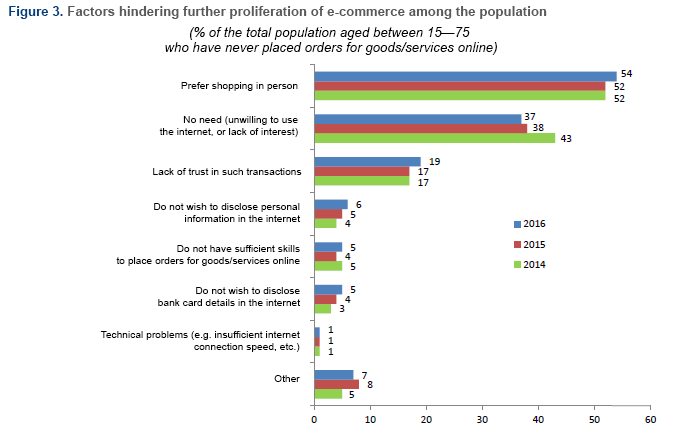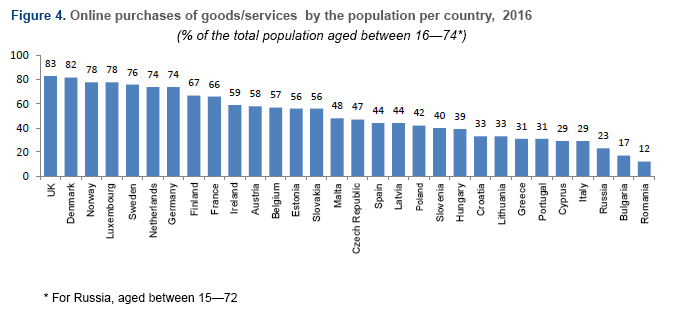E-commerce in Russia
Just 20 years ago very few people could imagine making purchases without leaving home. But now, thanks to the development of network technologies, we have adopted totally different practices, e-commerce among them.
E-commerce means placing an order (making an obligation to buy goods or services) via global information networks; note that payments or delivery don’t necessarily have to be made via information networks as well. Web sites or automated systems for exchanging data between enterprises, national and local authorities, and population can be used for e-commerce purposes. Exchanging ordinary emails, or placing orders via telephone or fax are not counted as e-commerce for statistical purposes1.
E-commerce technologies are popular among individuals and enterprises alike.
Online purchases by the population
In 2014—2016 the share of e-commerce users among the Russian population aged between 15—72 grew by 5 percentage points, reaching 23%. 30% of internet users placed orders for goods and services (figure 1).

Goods most frequently purchased via the internet include “Clothes, footwear, and sporting goods” (48% of online shoppers), “Household goods” (26%), and “Electronic equipment” (14%). Least popular is purchasing important life-support products via the net, such as food (9%) and medical products (10%).
As to procurement of services, financial ones lead: since 2014 the share of their users grew by 10% (the highest growth among all product and service groups purchased via the internet), reaching 29%. The population also actively use the internet to book trips, buy tickets for entertainment events, and pay for telecommunication services (18% each) (figure 2).

As to making payments for online purchases, cashless transactions are becoming increasingly popular: in the last three years the share of people who have paid for their online orders with bank cards grew 1.5 times (from 47 to 68% of the number of e-commerce users). Slightly more than a third of them (37% of the respondents who have made online purchases) preferred paying cash.
The most significant factor hindering further proliferation of e-commerce among the population was people’s preference to shop in person: it was cited by more than a half (54%) of the respondents who made their purchases only offline (i.e. have never used network technologies). 37% of potential shoppers have never felt the need to try new ways of buying things, and 19% completely distrusted such transactions (figure 3).
People in Russia make online purchases more than two times less often than in the EU countries (23 and 55%, respectively), while the gap with the leaders (UK and Denmark) is more than three times (figure 4). Low e-commerce usage figures were also noted in Bulgaria (17%) and Romania (12%).

International experience gives grounds to hope that as people’s trust in e-commerce increases, it will turn into a full-fledged shopping format.
Enterprises’ online interaction with suppliers and customers
Business sector enterprises actively use the internet to interact with their suppliers and customers, in particular, get information about products and services (more than 60%) and their prices (41%). In 2015 12% of the sector’s organisations made online sales, and 17% made online purchases via websites, extranet, or EDI-systems. Companies specialising in communications, production and distribution of electricity, gas, and water, wholesale and retail trade, manufacturing, hospitality, and catering are most actively involved in e-commerce (figure 5).
Russian e-commerce figures for the business sector are 5—7 percentage points below the average values for the EU where 17% of companies make online sales, and 24% — online purchases.

The data presented below shows that Russian companies do not use e-commerce as actively as the EU ones do. Putting in place an adequate legal framework, and providing relevant economic incentives should contribute to further proliferation of these practices.
The newsletter is based on data collected in the course of federal statistical observations using forms № 1-IT “Questionnaire for sample surveys of the population to assess usage of information technology, information and telecommunication networks”, and № 3-inform “Data about usage of information and communication technology, production of computer hardware and software, and provision of related services”, and the Eurostat database.
The calculations were made by the HSE ISSEK in the scope of the project “Development of theoretical and methodological approaches to studying activities of innovation process participants” of the HSE Basic Research Programme.
By Gulnara Abdrakhmanova, Marina Kevesh
1 Gokhberg L.M. (editor) (2012) Economics of knowledge in statistical terms: science, technology, innovation, education, information society: dictionary. M.: Ekonomika (in Russian)
